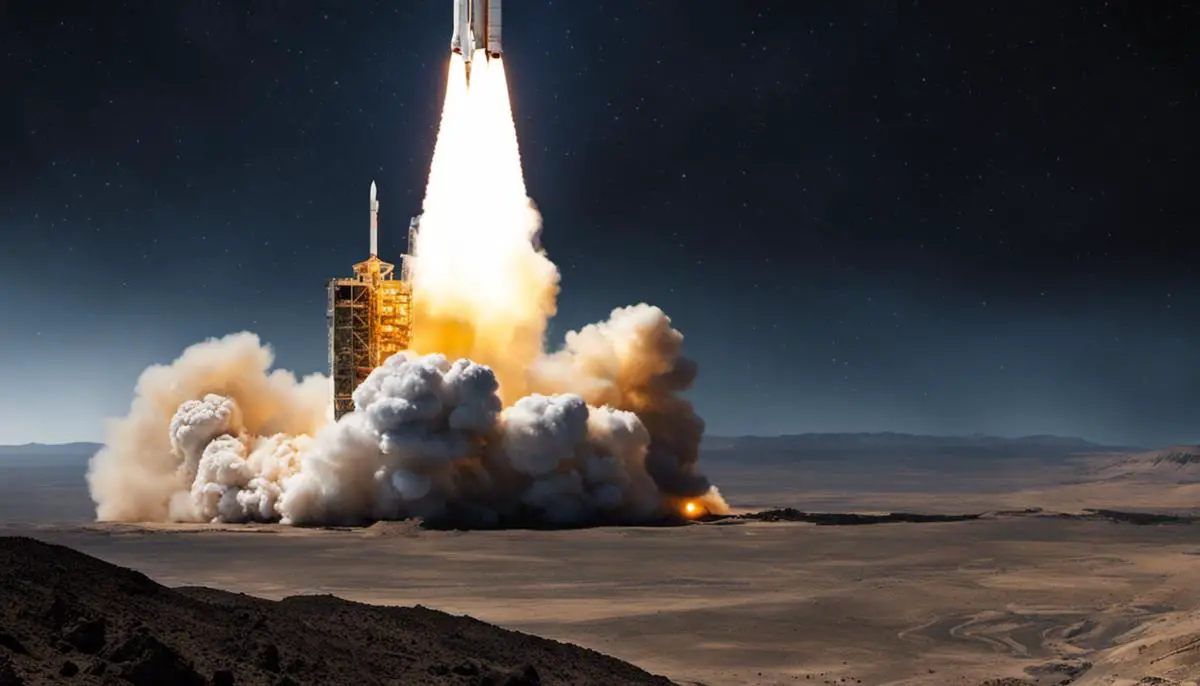Astounding leaps and bounds in space exploration have been witnessed in the past decade, with the OSIRIS-REx mission being a seminal venture that profoundly shook our understanding of the cosmos. Launched by NASA, OSIRIS-REx embarked on an ambitious mission to rendezvous with the near-Earth asteroid Bennu, gather samples, and return to Earth. By examining the origins of OSIRIS-REx, comprehending its technical aspects, appreciating its scientific accomplishments, and understanding its profound impact on future space expeditions, one steps into an enthralling narrative of human curiosity, scientific courage, and engineering genius that resonates with the universal quest to understand our place in the universe.
Origins of OSIRIS-REx
Genesis and Progression of the OSIRIS-REx Mission: An Exemplar of Scientific Pursuit
Dedicated to understanding and preserving our cosmic neighborhood, NASA is no stranger to complex and groundbreaking initiatives. One such initiative, which occupies an indelible place in the annals of space exploration, is the Origins, Spectral Interpretation, Resource Identification, Security-Regolith Explorer, or the OSIRIS-REx Mission. The inception of this pioneering mission was prompted by our intrinsic need to comprehend further the enigma that is the Universe.
The urge to comprehend the origin and evolution of our solar system – a longstanding quest in the human scientific enterprise – underpinned the conception of the OSIRIS-REx initiative. The focal point of this endeavor revolves around the asteroid Bennu, an ancient relic from our solar system’s formative period, which holds possibly invaluable insights into the genesis and progression of celestial bodies.
In an existential and somewhat philosophical sense, one might argue that the OSIRIS-REx mission seeks to uncover the ancestral roots of Earth and, by extension, humanity. This endeavor shields a practical objective as well: to analyze the feasibility and implications of near-Earth asteroid mining. By studying the composition and extracting samples, potential resources for future space exploration and even Earth’s consumption could be discovered.
The tangible security repercussions were another driving force behind the mission’s development. Being a Potentially Hazardous Asteroid (PHA), Bennu, due to its size and proximity, carries a risk of Earth impact in the late 22nd century. The OSIRIS-REx mission aims to study the non-gravitational forces acting upon Bennu through a phenomenon called the Yarkovsky Effect, informing mitigation strategies for any imminent asteroid threats.
The comprehensive knowledge required for this mission underscores the immense dedication and rigorous scientific methodology employed by numerous researchers, scientists, engineers, and other stakeholders. This collective effort is characterized by an unprecedented degree of precision, extending from the spacecraft’s launch to its intricate touch-and-go (TAG) sample collection maneuver.
The deep-space sojourn of OSIRIS-REx can be seen not merely as a space mission, but as an allegory of human curiosity, scientific rigor, and our insatiable quest for knowledge. In bridging our understanding of the Universe’s past and present, it offers pathways to negotiate and shape our future with enhanced cosmic wisdom. In essence, the OSIRIS-REx mission encapsulates the relentless human spirit striving for discovery and progress. It stands as a testament that the quest for knowledge, even when pursued
across astronomical distances, remains at the heart of our collective scientific endeavor.
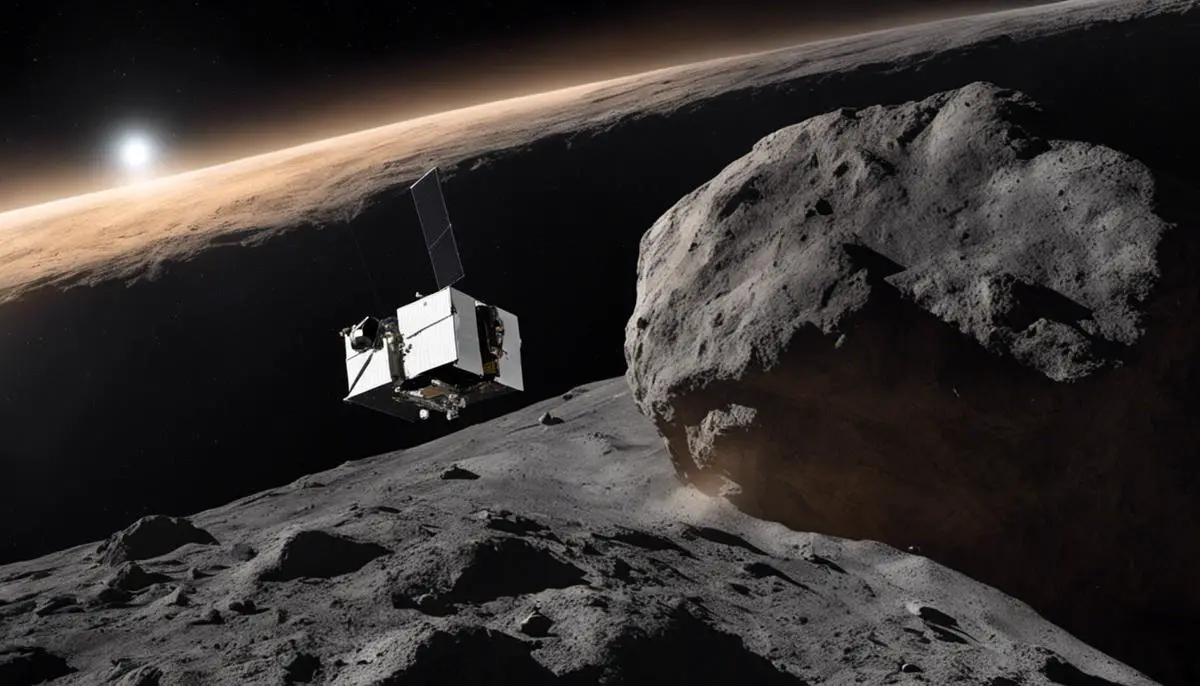
Technical Aspects and Challenges of OSIRIS-REx
The OSIRIS-REx mission, a monumental technological endeavor that successfully reached the asteroid Bennu and returned samples to Earth, hinged upon a series of innovative instruments and techniques, each designed with a particular challenge in mind.
One such innovation was the development of the OSIRIS-REx Visible and Infrared Spectrometer (OVIRS). This instrument was designed to measure light reflected and emitted from Bennu to identify the mineral and molecular components present on the asteroid’s surface. The knowledge gained from the OVIRS contributes to our understanding and identification of the critical elements of an asteroid’s composition – a task never before achieved at this level of intricate detail.
The spacecraft also leveraged the ingenuity of Touch-And-Go-Sample Acquisition Mechanism (TAGSAM), an instrument using bursts of nitrogen gas to release and collect gravel and dust from the asteroid’s surface. This unique method provided a crucial solution to the challenge of sample collection in microgravity, a hitherto unexplored frontier in space exploration.
Moving to navigation, one of the enabling technologies was the Natural Feature Tracking (NFT) system. It is an autonomous navigation system that allowed OSIRIS-REx to precisely navigate for its rendezvous with Bennu using landmarks on the asteroid’s surface.
Indeed, the success of the mission cannot be divorced from these remarkable technologies, but it is also essential to reflect upon the hurdles encountered and how these were navigated. One such challenge included the surprising discovery of Bennu’s boulder-laden surface. Initial observations suggested relatively smooth terrains, but upon the spacecraft’s arrival, the surface was found to be strewn with rocks and boulders, making the originally planned two-site sample collection unfeasible. This necessitated a redesign of the mission to a single-site approach, a nimble adaptation indicative of the dynamic nature of these space explorations.
Another significant hurdle was the need to perform the mission’s critical maneuvers millions of kilometers away from Earth. This required a high degree of automation to tackle the several minutes-long communication delay between the spacecraft and its control team. The confluence of sheer distance and stringent timing need called for innovative ways to ensure the commands were executed accurately and in a timely fashion.
In conclusion, when bound on a course towards the unknown, creativity often stands as the most substantial remaining resource. This blend of innovation and adaptability, typified in pursuits such as OSIRIS-REx, demonstrates not just scientific prowess, but testifies to the indomitable human spirit, as we seek to unlock the mysteries of our universe amidst the vast cosmos that envelops us.
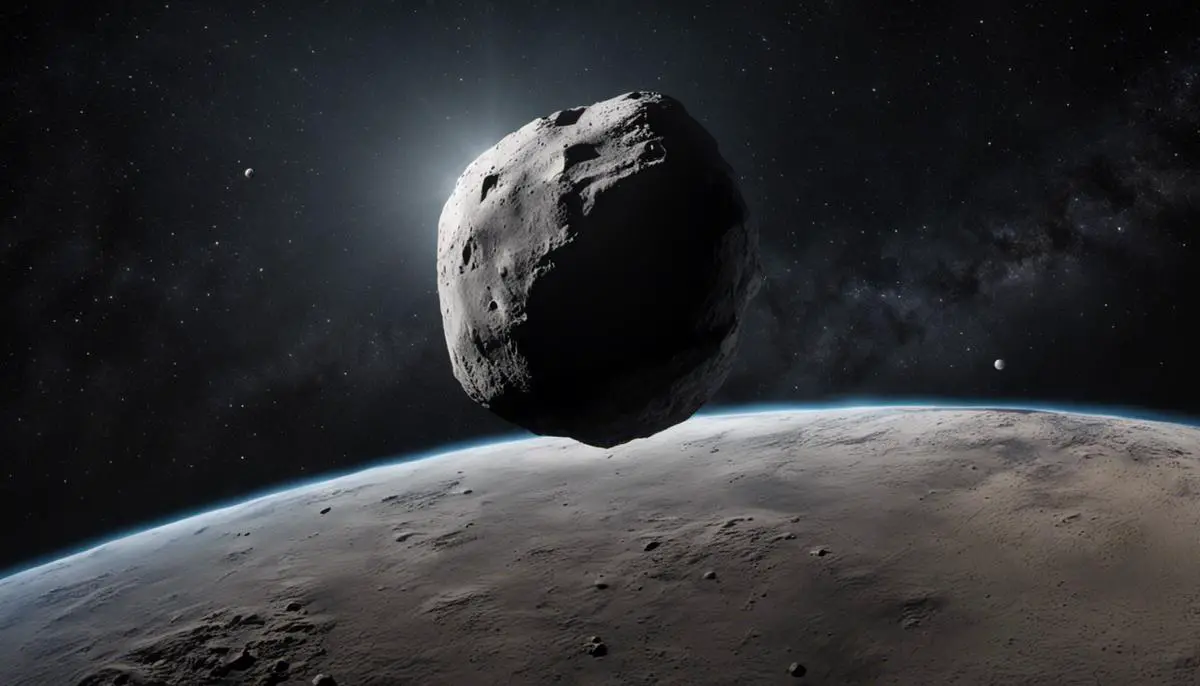
The Scientific Achievements of OSIRIS-REx
Building on the pillars of comprehension and curiosity intertwined within space science, the OSIRIS-REx mission showcases a series of audacious advances and discoveries in the discipline. An exemplary illustration of the blending of technology, precision, and knowledge, it sets a milestone in our cosmic journey as it forays into understanding Bennu, a celestial canvas marked by the footprints of our solar system’s inception.
Delving into the novelty introduced by the mission, the OSIRIS-REx Visible and Infrared Spectrometer (OVIRS) emerges as a salient device. OVIRS allows for the discernment of the asteroid’s composition over a wide spectral range, thus characterizing the materials on Bennu’s surface, and effectively marking this asteroid’s significance in studying the primeval constituents of our solar system. This data is paramount for attesting theories regarding the early solar system and life’s building blocks.
Notably, universe exploration endeavors hinge on state-of-the-art techniques and devices, and the Touch-And-Go Sample Acquisition Mechanism (TAGSAM) housed within OSIRIS-REx channels this ethos. The uniqueness of TAGSAM resides in its capability to collect samples from Bennu’s surface using a swift ‘touch and go’ motion. This novel approach negates the requirement for a cumbersome and risky landing, allowing the acquisition of precious extraterrestrial materials with lessened risk and enhanced efficiency.
Complementary to these formidable devices, the Natural Feature Tracking (NFT) system further ensures the mission’s success. This technological marvel is critical for navigation, as it maps the terrain of Bennu to create a three-dimensional model. As the spacecraft approaches the asteroid, it utilizes this model to update its location and adjust its trajectory – injecting the mission with a dynamic fluidity unachievable otherwise.
While the OSIRIS-REx mission articulates the power of scientific ingenuity and determination, it is not devoid of challenges. A notable example is the initially unexpected rugged landscape of Bennu. When OSIRIS-REx began relaying images back to Earth, scientists were taken aback by the boulder-strewn surface instead of the expected sandy terrain. However, the robustness of mission design, underscored by the capabilities of the NFT system, enabled the successful circumnavigation of these obstacles, allowing for the meticulous selection of a safe and scientifically valuable sampling location.
The complex journey of OSIRIS-REx indeed embodies the essence of the dynamic nature of space exploration – a constant interplay of prediction, innovation, and adaptability. It presents an adaptive script that gradually unfolds as the mission circumvents unforeseen challenges and pursues unprecedented accomplishments.
The OSIRIS-REx mission indeed stands as a testament to humanity’s unwavering intention of pushing the frontiers of existing knowledge. Each iteration propelling forward not mere machines, but the collective dreams and aspirations of humanity. It carries within it an echo of an unquenchable thirst for understanding, a commitment towards the search for cosmic truths, plunging the depths of the space around us, and continuously reshaping our conceptions of the universe in which we exist.
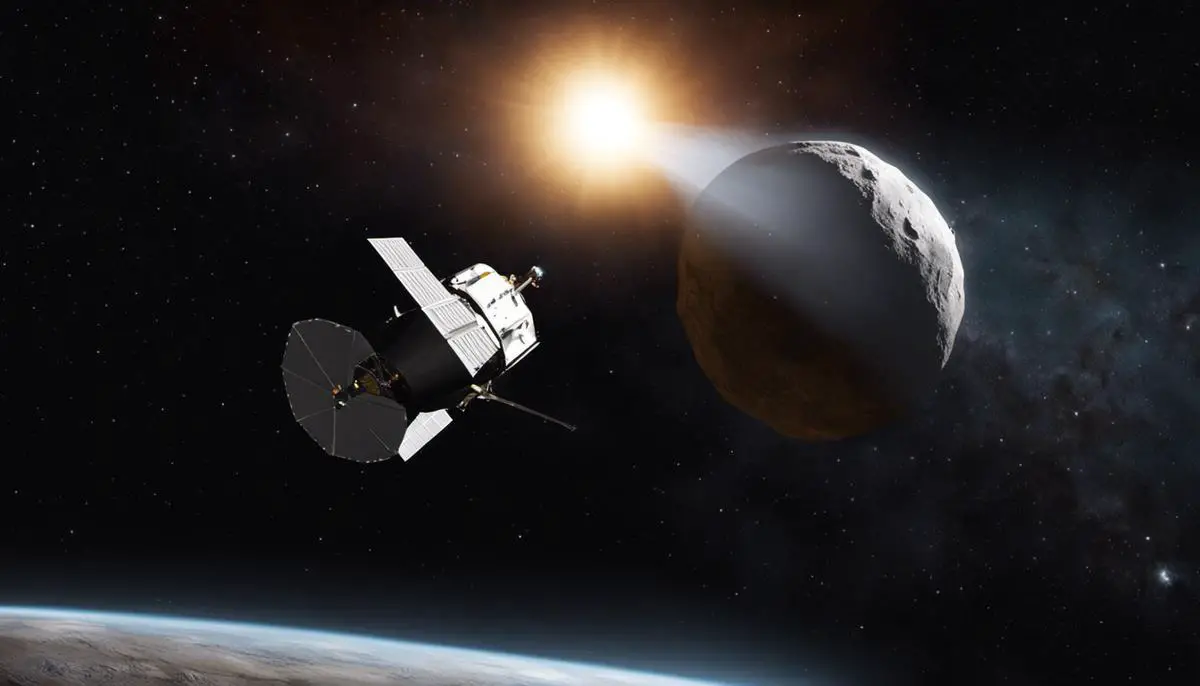
The Influence of OSIRIS-REx on Future Space Exploration
The OSIRIS-REx mission, in a remarkable demonstration of humanity’s scientific and technological prowess, has offered insightful lessons and crucial precedents to future space explorations. Comprising a suite of distinguishing features – from the OSIRIS-REx Visible and Infrared Spectrometer (OVIRS), to the innovative Touch-And-Go Sample Acquisition Mechanism (TAGSAM), to the trailblazing Natural Feature Tracking (NFT) system – the mission stands as a testament to the inexhaustible purchase of human curiosity on the edifice of space science, especially as it pertains to the study of asteroids.
The OSIRIS-REx, armed with its OVIRS, decodes light from asteroid Bennu into distinct wavelengths, a mission task that has not just elucidated the geological composition and mineral distribution of Bennu, but has set a benchmark for future explorations aiming to unravel the mysteries of celestial bodies. Notable are the astounding spectral databases which this mission has generated, providing a new paradigm in tracking and distinguishing asteroids by their physical and compositional properties.
The ingenious TAGSAM system employed by OSIRIS-REx has also paved the way for safe and efficient extra-terrestrial sample collection. By expelling a blast of nitrogen gas to stir up surface material and capturing the particulate in a sampling head, TAGSAM allows for a rather swift and non-percussive ‘touch-and-go’ maneuver. This departure from the traditional digging or drilling method has surpassed expectations, hinting at a framework for future missions requiring sample acquisition.
Equally commendable is OSIRIS-REx’s use of its NFT system. Utilizing images captured during the spacecraft’s approach to Bennu, the NFT generates a model of the asteroid’s terrain and helps the spacecraft adjust its trajectory autonomously – a milestone strategy in navigating small celestial bodies. Innovative navigation techniques like this bear immense potential for future missions seeking to reach remote or challenging destinations within our cosmic neighborhood.
Yet the voyage of OSIRIS-REx was not devoid of challenges. Unforeseen surface features of Bennu, including rugged terrains and massive boulders, necessitated unforeseen long-distance maneuvers. The ability to quickly adapt, a quality indispensable to the field of space science, was reflected resoundingly in the mission’s successful coping strategies. Such adaptability, though tested, only substantiated the resilience and expansive potential of humanity in its quest to conqeur extraterrestrial quandaries.
In totality, the OSIRIS-REx mission has remarkebly enriched humanity’s interplanetary exploration strategies, pioneering key methodologies and techniques that have reshaped our approach toward cosmic quests. Extending its tradition of innovation, humanity stands poised to capitalize on the collective insights gathered from Bennu, further unraveling the tapestry of the universe and writing a new chapter in the annals of space exploration.
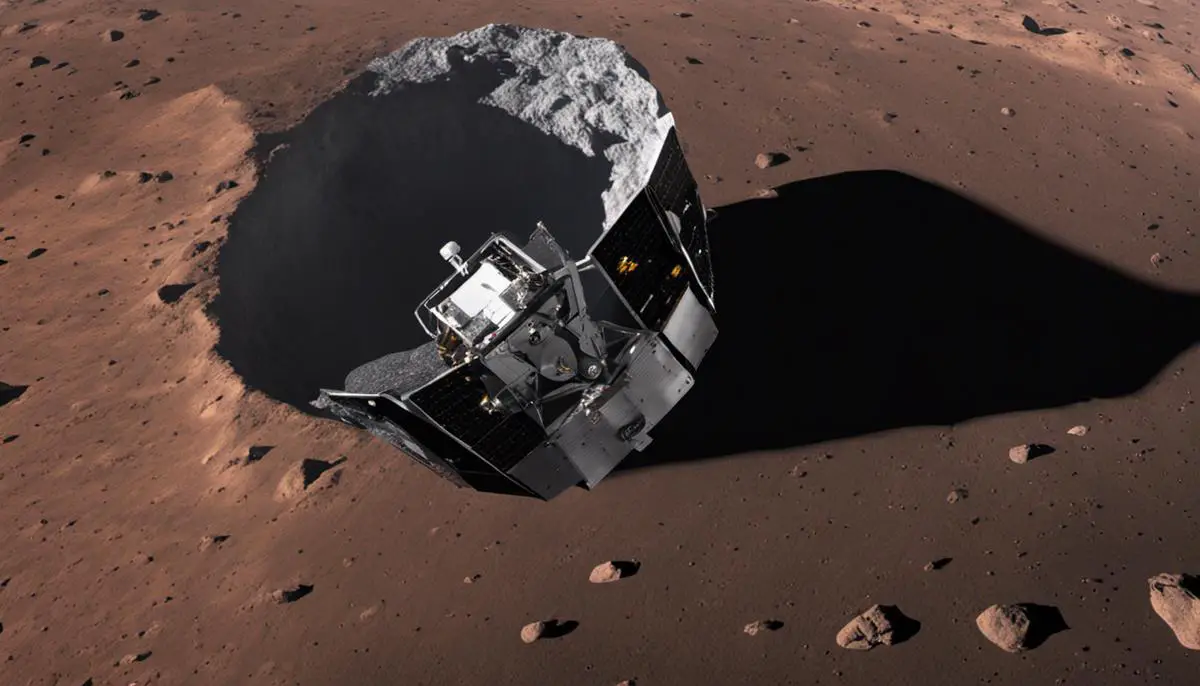
The trailblazing OSIRIS-REx mission has arguably whetted our appetite for further adventures in space exploration. With its impact reverberating across the realms of astrobiology, planetary defense, and fundamental space sciences, it has sparked new questions, paved new avenues of investigation, and inspired a rising generation of aspiring explorers. The indelible mark left by OSIRIS-REx continues to inspire not only future small body missions but the broader domain of planetary exploration, fostering the growth of knowledge that defines our very existence. The echo of its intrigue will permeate decades to come, heralding an era of anticipation and discovery in our cosmic voyage.
FAQ
What are the 4 types of space missions?
Space missions can be broadly divided into four primary categories, each of which has a specific function in the study and exploration of space. First, spacecraft are dispatched to other celestial bodies to collect data without the need for human astronauts. These missions are known as robotic or unmanned missions. These missions are essential to scientific study because they can withstand challenging circumstances and gather important data. Secondly, crewed missions send humans into space to carry out repairs, carry out research, and take part in direct exploration. These missions allow the completion of difficult tasks that are beyond the scope of robotic missions and advance our understanding of human adaptability in space. Observatory missions, which use telescopes and other equipment to observe far-off astronomical objects and phenomena without interference from Earth’s atmosphere, are under the third category. Lastly, visiting different planets in our solar system in order to learn more about their surfaces, atmospheres, and geological aspects is known as an interplanetary mission. Every one of these mission categories contributes significantly to expanding the frontiers of space exploration and deepening our understanding of the cosmos.
What are the 3 types of space exploration?
A wide range of endeavors are included in space exploration with the goal of comprehending and engaging with the enormous void that exists outside of Earth’s atmosphere. Astronomical observation, robotic exploration, and human spaceflight are the three basic categories into which space exploration can be divided. Sending unmanned spacecraft to investigate far-off celestial planets, gather information, and carry out experiments is known as robotic exploration. These missions greatly advance our knowledge of the solar system and beyond, are inexpensive, and resilient in harsh environments. Sending people into space to carry out repairs, carry out experiments, and engage in hands-on exploration is known as human spaceflight. In addition to advancing scientific understanding, this kind of exploration shows how adaptive and clever humans can be in the harsh environment of space. In contrast to Earth-based observations, astronomical observation uses telescopes and other tools to examine celestial objects and events in space, offering more lucid and unhindered views. When combined, these three categories of space exploration are essential for deepening our knowledge of the universe and raising the bar for human accomplishment.
What are the names of the 4 space programs?
Space exploration has advanced thanks in large part to a number of space missions. The National Aeronautics and Space Administration (NASA) of the United States is one of four well-known space projects. NASA has led the way in human spaceflight, scientific research, and space exploration. The Russian space agency, Roscosmos, has a long history of space activity and is still involved in international space projects. The European Space Agency (ESA) is an example of how European nations are working together to explore and investigate space. The Indian Space Research Organization, or ISRO, has also received praise for its accomplishments in interplanetary travel, satellite deployment, and affordable space missions.
What is NASA’s most famous mission?
The Apollo 11 mission, which accomplished the momentous feat of landing the first humans on the Moon, is undoubtedly NASA’s most well-known project. Michael Collins, Buzz Aldrin, and Neil Armstrong were among the astronauts aboard the spacecraft when it was launched on July 16, 1969. When Neil Armstrong stepped foot on the moon for the first time on July 20, 1969, he said the famous words, “That’s one small step for man, one giant leap for mankind.” Not long after, Buzz Aldrin joined him, with Michael Collins circling overhead. The lofty objective set by President John F. Kennedy to land people on the moon and safely return them to Earth by the end of the 1960s was achieved with the successful completion of Apollo 11. This mission continues to stand for the accomplishments of humanity, space travel, and the quest for knowledge beyond Earth.
What is the most famous space mission?
The most well-known space mission may differ depending on personal viewpoints and is therefore a subjective decision. But among the most well-known space missions worldwide is NASA’s Apollo 11 mission, which took place in 1969. As the first and second humans to step foot on the lunar surface, respectively, astronauts Neil Armstrong and Buzz Aldrin accomplished the incredible feat of landing the first humans on the moon during this historic expedition. “That’s one small step for man, one giant leap for mankind,” Armstrong famously said, reverberates as a testament to human progress and discovery. The Apollo 11 mission captured the interest of people all across the world, contributing to our understanding of the universe and representing a momentous milestone in space research.
![]()
